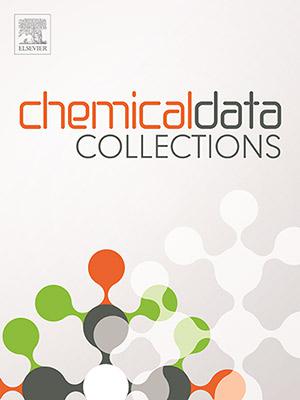4-羟基-2-(4-羟基苯基)-1-甲基-5-氧-2,5-二氢- 1h -吡咯-3-羧酸乙酯的合成、晶体结构和Hirshfeld表面分析
IF 2.218
Q2 Chemistry
引用次数: 0
摘要
以草酸二乙酯钠、甲胺和4-羟基苯甲醛为原料,通过多组分反应合成了4-羟基-2-(4-羟基苯基)-1-甲基-5-氧-2,5-二氢- 1h -吡咯-3-羧酸乙酯C14H15NO5(1)。利用红外光谱(FT-IR)、核磁共振(NMR)和气相色谱(GCMS)对其结构进行了表征。这些结果通过单晶x射线晶体学进一步证实。结果表明:1在正交空间群Pca21中结晶,其中a = 17.102(4), b = 9.923(2), c = 16.037(4), Å。通过Hirshfeld表面分析得到了分子间相互作用在晶体结构中的量化结果,表明H···H接触是最主要的相互作用。本文章由计算机程序翻译,如有差异,请以英文原文为准。
Synthesis, crystal structure and Hirshfeld surface analysis of ethyl 4-hydroxy-2-(4-hydroxyphenyl)-1-methyl-5-oxo-2,5-dihydro-1H-pyrrole-3-carboxylate
Ethyl 4‑hydroxy-2-(4-hydroxyphenyl)-1-methyl-5-oxo-2,5-dihydro-1H-pyrrole-3-carboxylate, C14H15NO5 (1) was synthesized via multicomponent reaction (MCR) of sodium diethyl oxalacetate, methylamine, and 4-hydroxybenzaldehyde. The structure of 1 was elucidated by using FT-IR, NMR and GCMS. These results were further confirmed by means of single crystal X-ray crystallography. The results showed that 1 was crystallized in orthorhombic space group Pca21 where a = 17.102(4), b = 9.923(2), c = 16.037(4), Å. The quantification of intermolecular interactions in the crystal structure was obtained by Hirshfeld surface analysis and showed that the H···H contacts were the most dominant interactions.
求助全文
通过发布文献求助,成功后即可免费获取论文全文。
去求助
来源期刊

Chemical Data Collections
Chemistry-Chemistry (all)
CiteScore
6.10
自引率
0.00%
发文量
169
审稿时长
24 days
期刊介绍:
Chemical Data Collections (CDC) provides a publication outlet for the increasing need to make research material and data easy to share and re-use. Publication of research data with CDC will allow scientists to: -Make their data easy to find and access -Benefit from the fast publication process -Contribute to proper data citation and attribution -Publish their intermediate and null/negative results -Receive recognition for the work that does not fit traditional article format. The research data will be published as ''data articles'' that support fast and easy submission and quick peer-review processes. Data articles introduced by CDC are short self-contained publications about research materials and data. They must provide the scientific context of the described work and contain the following elements: a title, list of authors (plus affiliations), abstract, keywords, graphical abstract, metadata table, main text and at least three references. The journal welcomes submissions focusing on (but not limited to) the following categories of research output: spectral data, syntheses, crystallographic data, computational simulations, molecular dynamics and models, physicochemical data, etc.
 求助内容:
求助内容: 应助结果提醒方式:
应助结果提醒方式:


